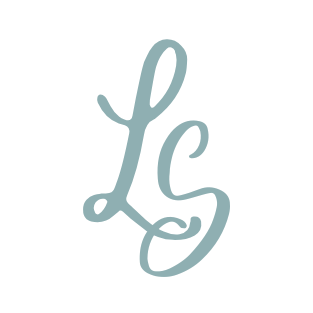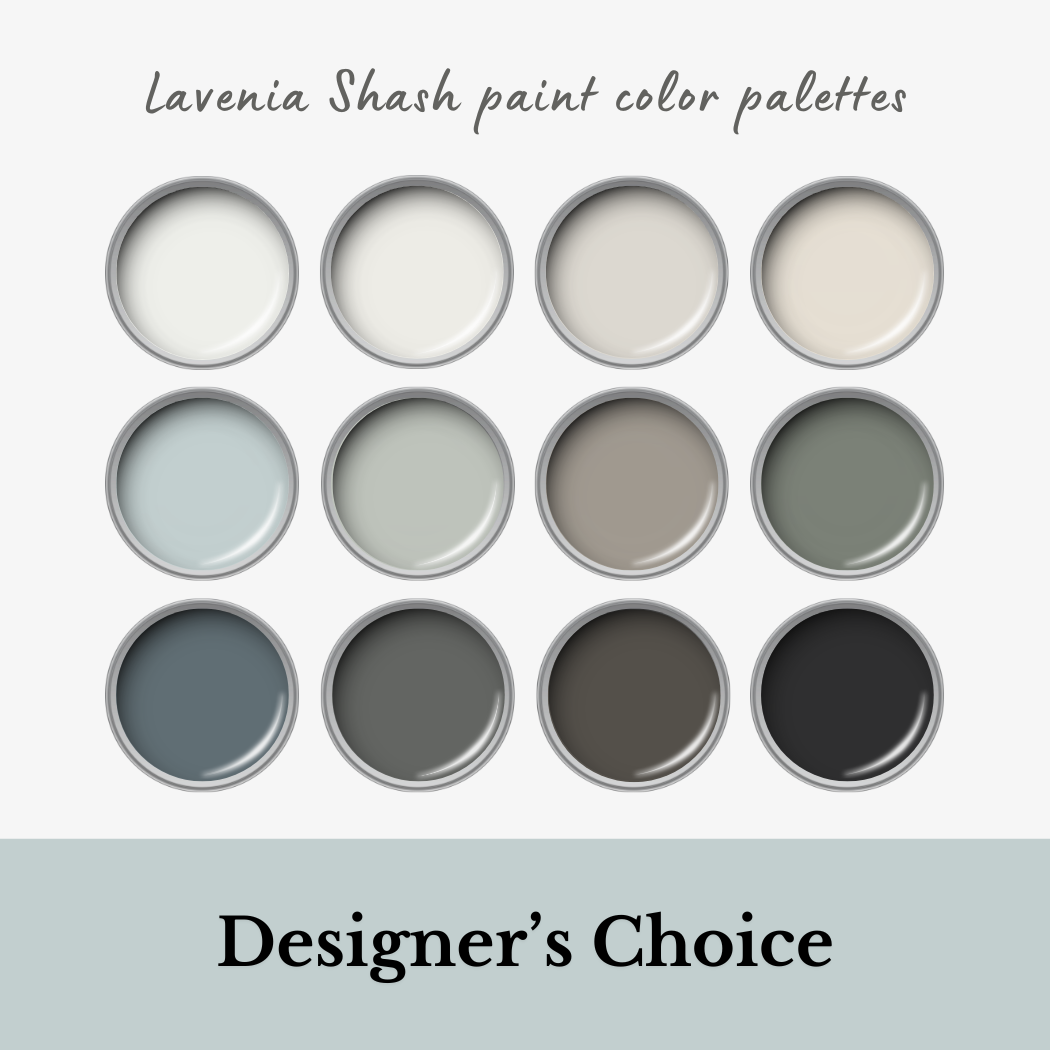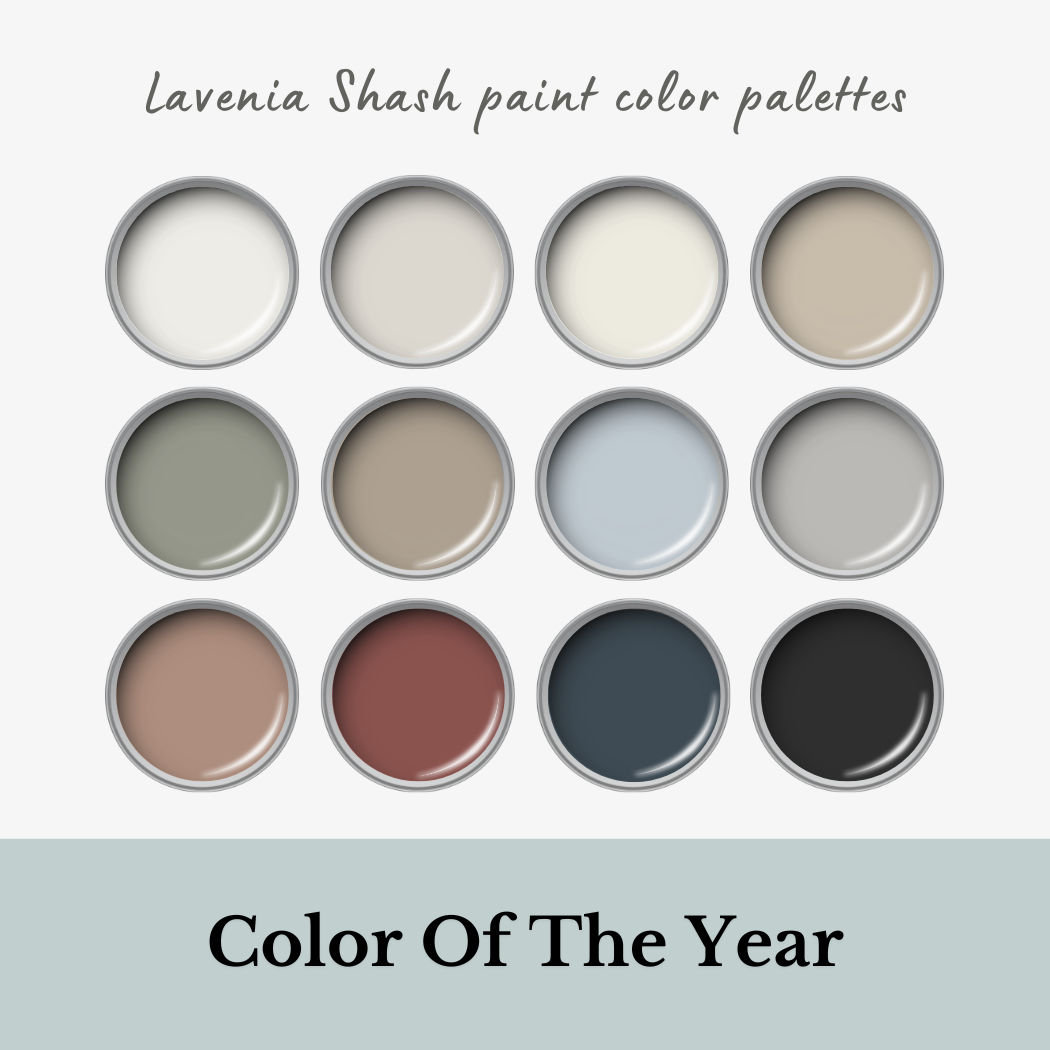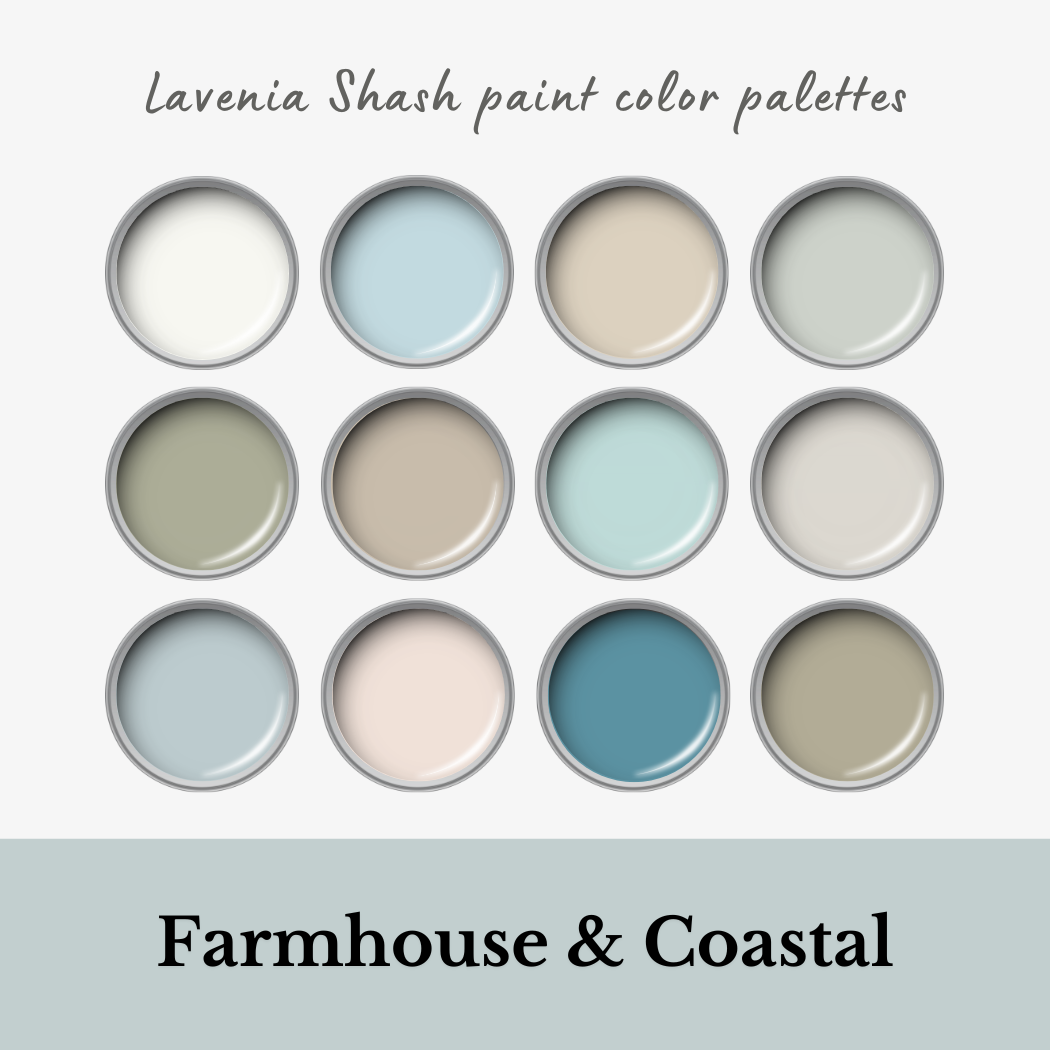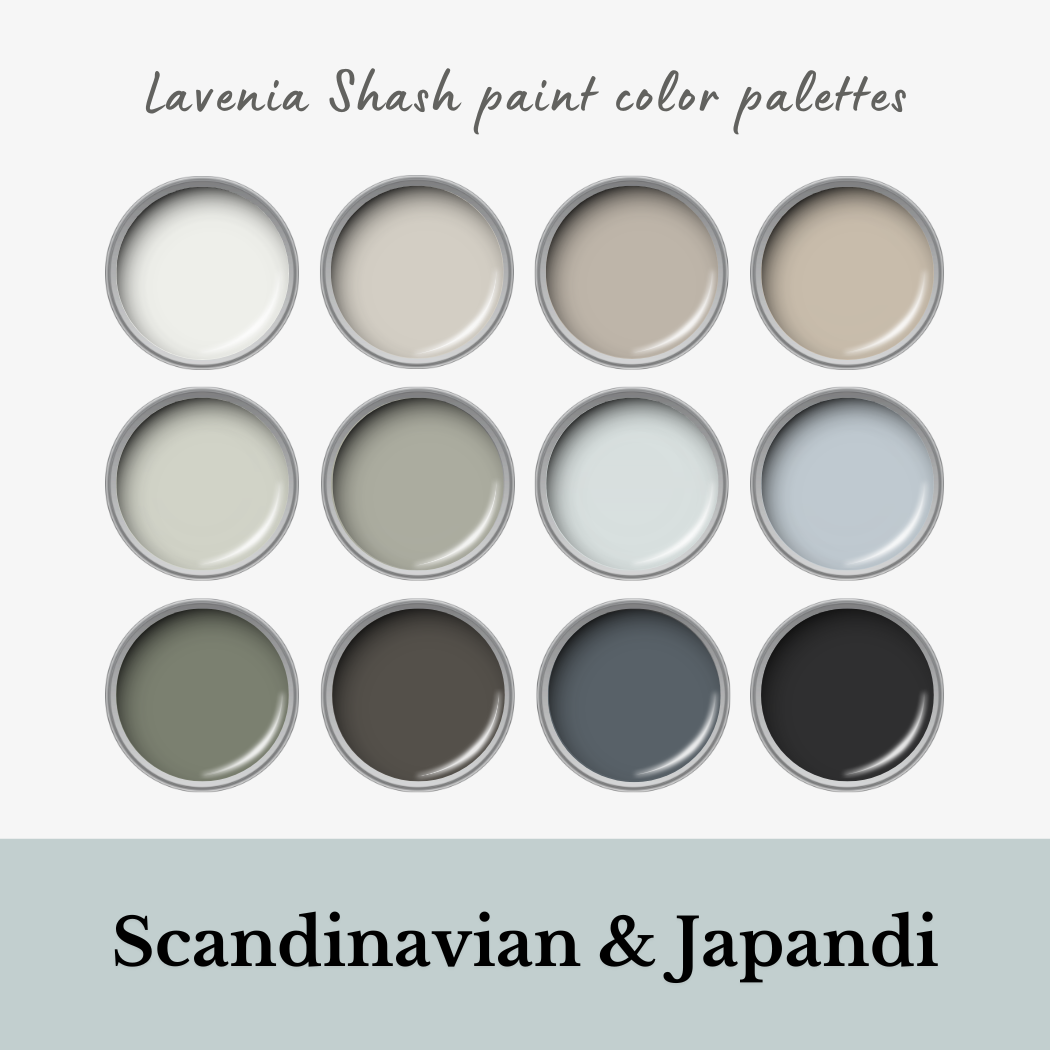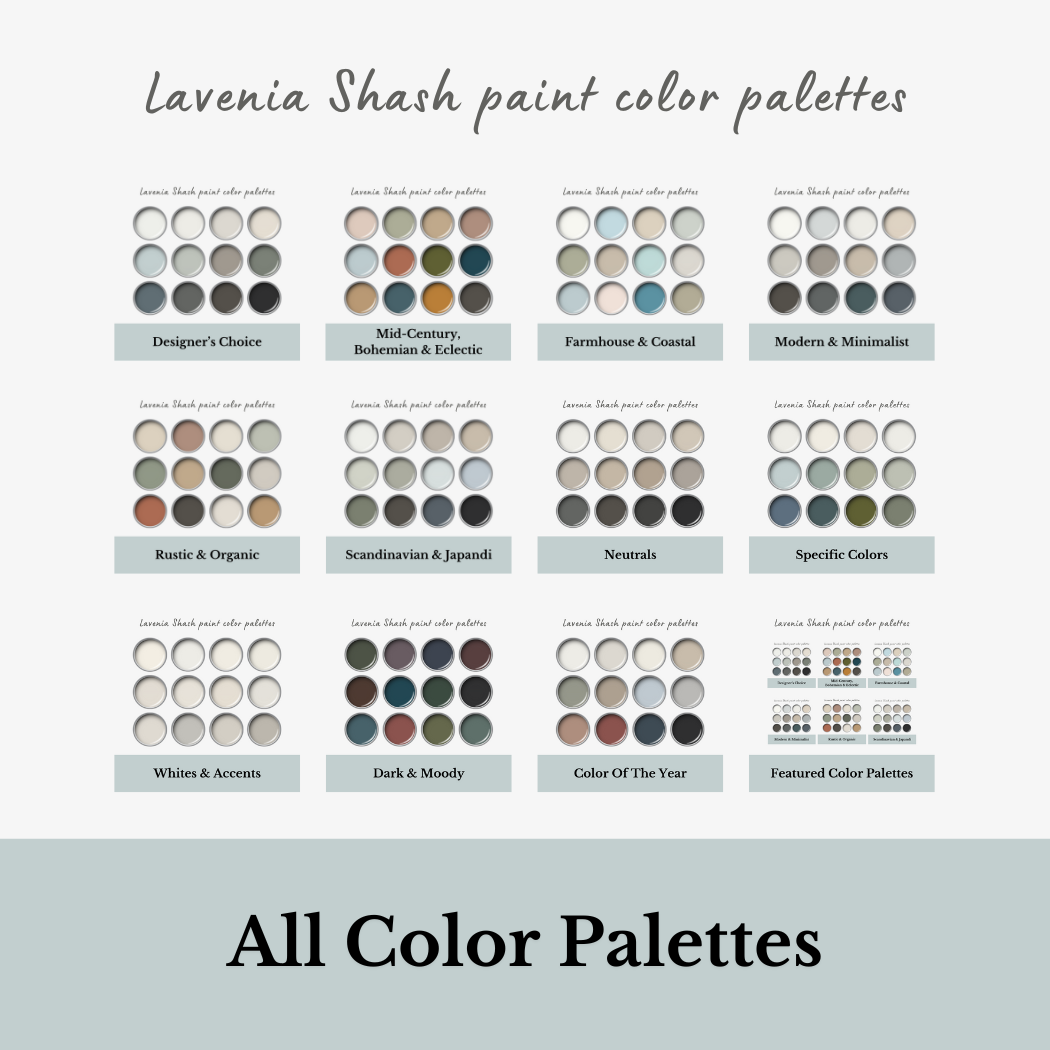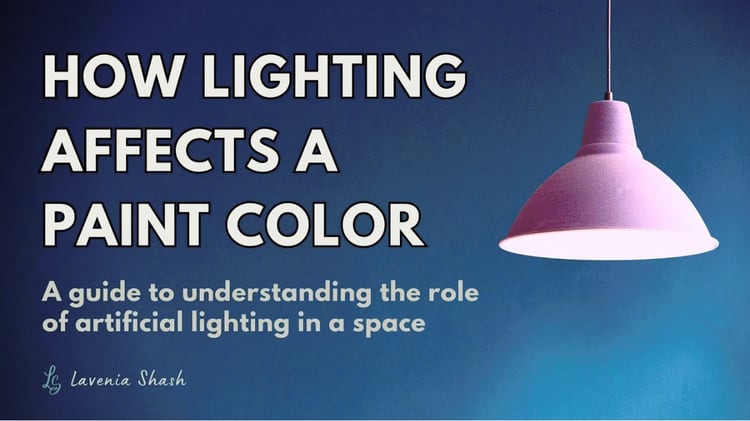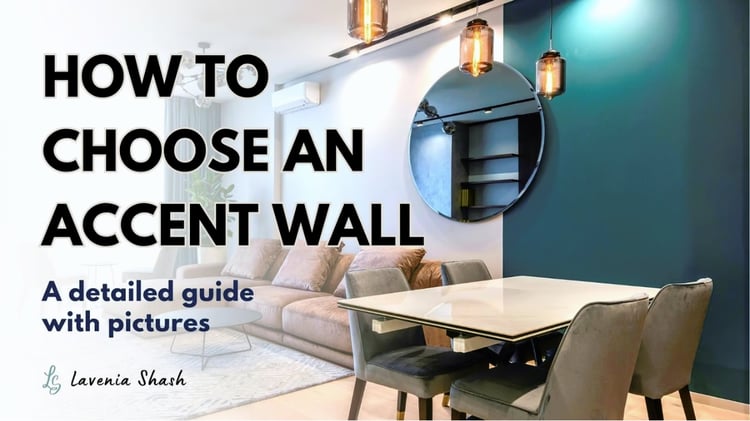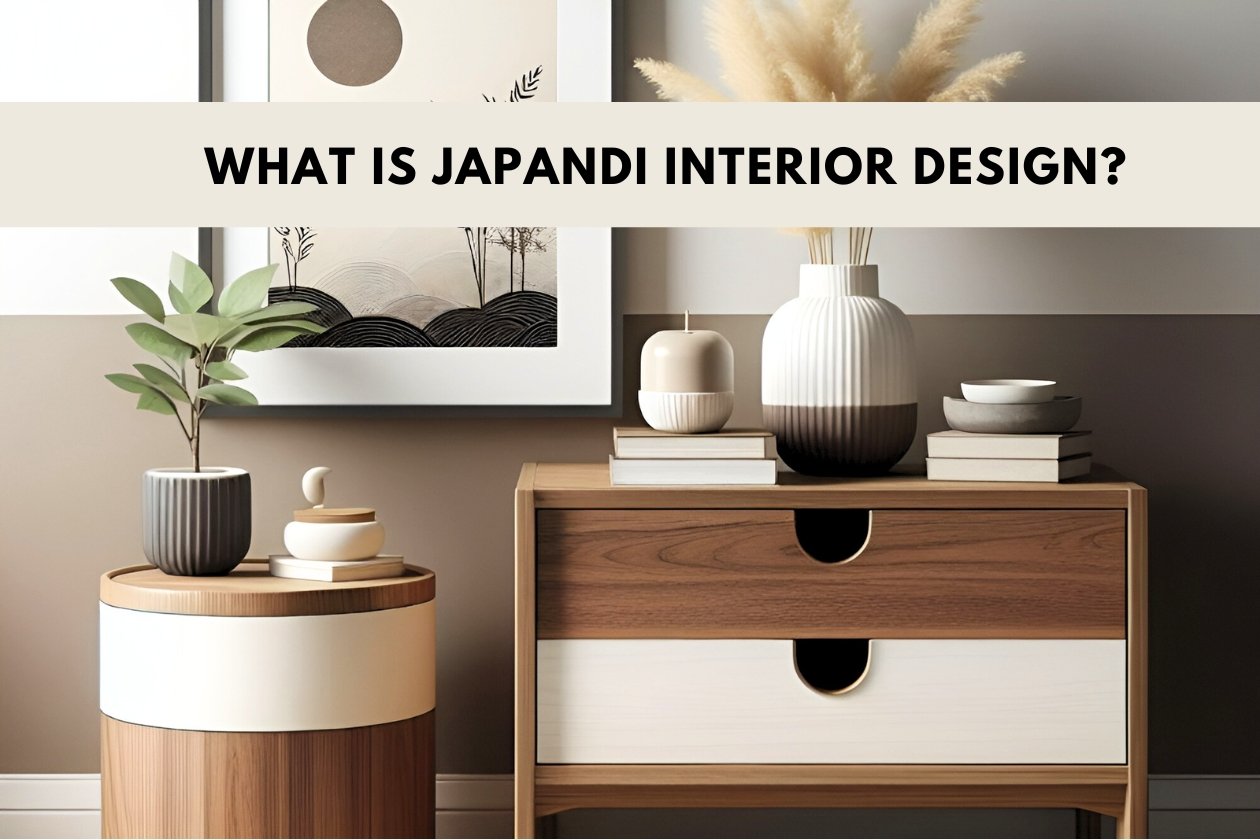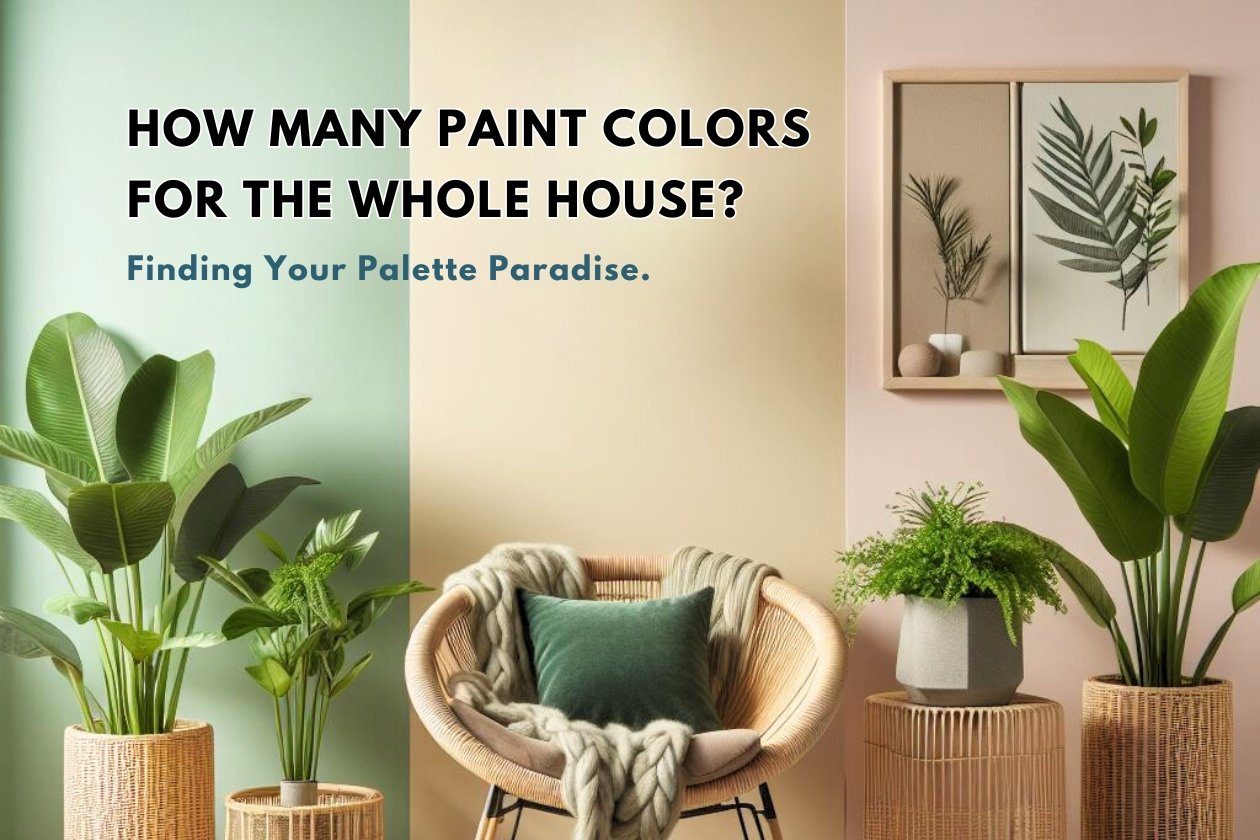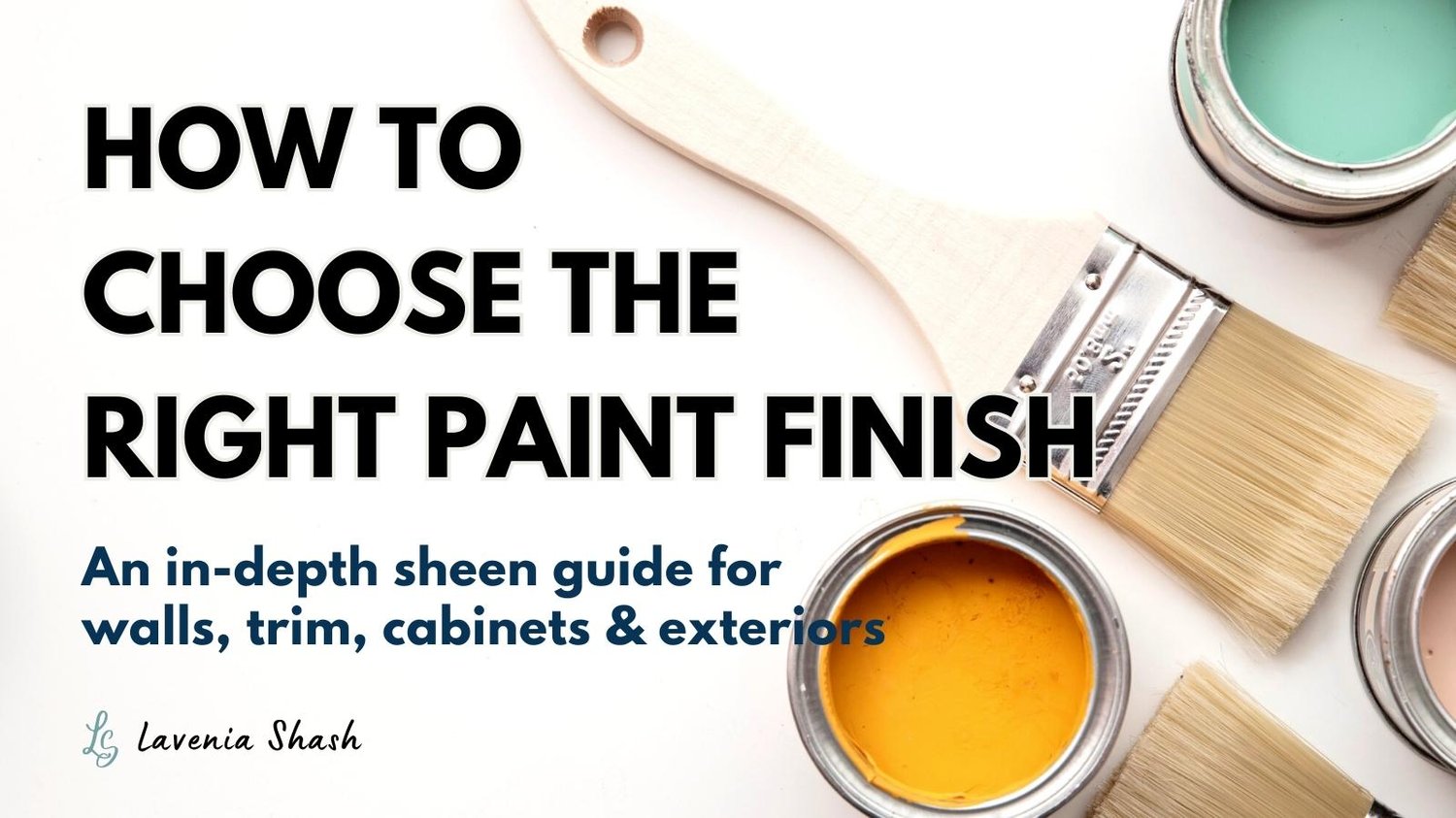

How to choose the right paint finish - An in-depth sheen guide for walls, trim, cabinets and exteriors.
In the realm of interior design, choosing the right finish for your walls, trim, and built-ins can make a remarkable difference in the overall look and feel of your space. From the subtle allure of a matte finish to the captivating brilliance of a high-gloss sheen, the options are as diverse as the styles and moods they can create. So, let us delve into the realm of paint finishes and sheen, exploring the recommended choices for different areas of your home, unlocking the secrets of enhancing aesthetics, durability, and the perfect touch of sophistication.
Questions covered on this topic -
- What are the types of paint finishes and sheens available?
- Do different parts of the home's interior need different finishes?
- What are the options available for exteriors?
- Which is the most common sheen for a front door?
- How popular is a satin finish for a front door?
- What should be taken into consideration before selecting a sheen?
- What finish should I choose if I do not favor a shiny look for my walls?
- Why isn't high gloss as popular as the other sheens?
- What is the best sheen for smooth walls vs rough/damaged walls vs textured walls?
- What finish is recommended for white or light colored walls?
- What finish is recommended for walls painted in a dark color?
- Should the sheen for trims be higher than the finish on a wall?
- Do different interior design styles call for different paint finishes?
- How does natural light interact with sheens?
- How does artificial light interact with sheens?
- Which sheen to use based on cardinal direction?
- Does the quality of paint matter for a sheen's durability?
- Which manufacturers produce high quality and durable wall paints?
What are the types of paint finishes and sheens available?
Paint finishes, also known as sheens or lusters, refer to the level of glossiness or shininess of a painted surface. The choice of paint finish can significantly impact the appearance, durability, and maintenance of the painted surface. Here's a guide to the most common paint finishes:
Flat/Matte Finish
Flat finishes have no sheen and provide a non-reflective, smooth appearance. They are ideal for hiding surface imperfections and are commonly used on ceilings and walls. However, they tend to be less durable and less stain-resistant than other finishes. They are not recommended for high-traffic areas or areas that require frequent cleaning. Gloss visibility - none to low.
Eggshell Finish
Eggshell finishes have a subtle sheen that resembles the texture of an eggshell. They offer a low to medium level of reflectivity and are more durable than flat finishes. Eggshell finishes are commonly used in living rooms, dining rooms, and bedrooms. They are easier to clean compared to flat finishes but may still show some marks and scuffs. Gloss visibility - low to medium low.
Satin Finish
Satin finishes have a smooth, velvety appearance and a slightly higher sheen than eggshell finishes. They offer a moderate level of reflectivity and are more durable and stain-resistant. Satin finishes are suitable for high-traffic areas such as hallways, kitchens, and bathrooms. They are easy to clean and can withstand mild scrubbing. Gloss visibility - medium low to medium.
Semi-Gloss Finish
Semi-gloss finishes have a noticeable sheen and provide a sleek, shiny appearance. They offer a higher level of reflectivity and are even more durable and stain-resistant than satin finishes. Semi-gloss finishes are commonly used on trim, doors, cabinets, and furniture. They are easy to clean and can withstand moderate scrubbing. Gloss visibility - medium to medium high.
Gloss Finish
Gloss finishes have the highest level of sheen and provide a highly reflective, mirror-like surface. They offer excellent durability and are highly resistant to stains, moisture, and wear. Gloss finishes are typically used for highlighting architectural details, such as railings, moldings, and furniture. They are easy to clean but can accentuate surface imperfections. Gloss visibility - high.
It's important to consider the specific requirements of the surface being painted and the desired aesthetic when selecting a paint finish. Some factors to consider include the level of foot traffic, the presence of children or pets, the amount of natural or artificial light in the space, and the desired level of maintenance. Many paint manufacturers offer sample swatches or small cans of paint for testing different finishes before committing to a larger project.
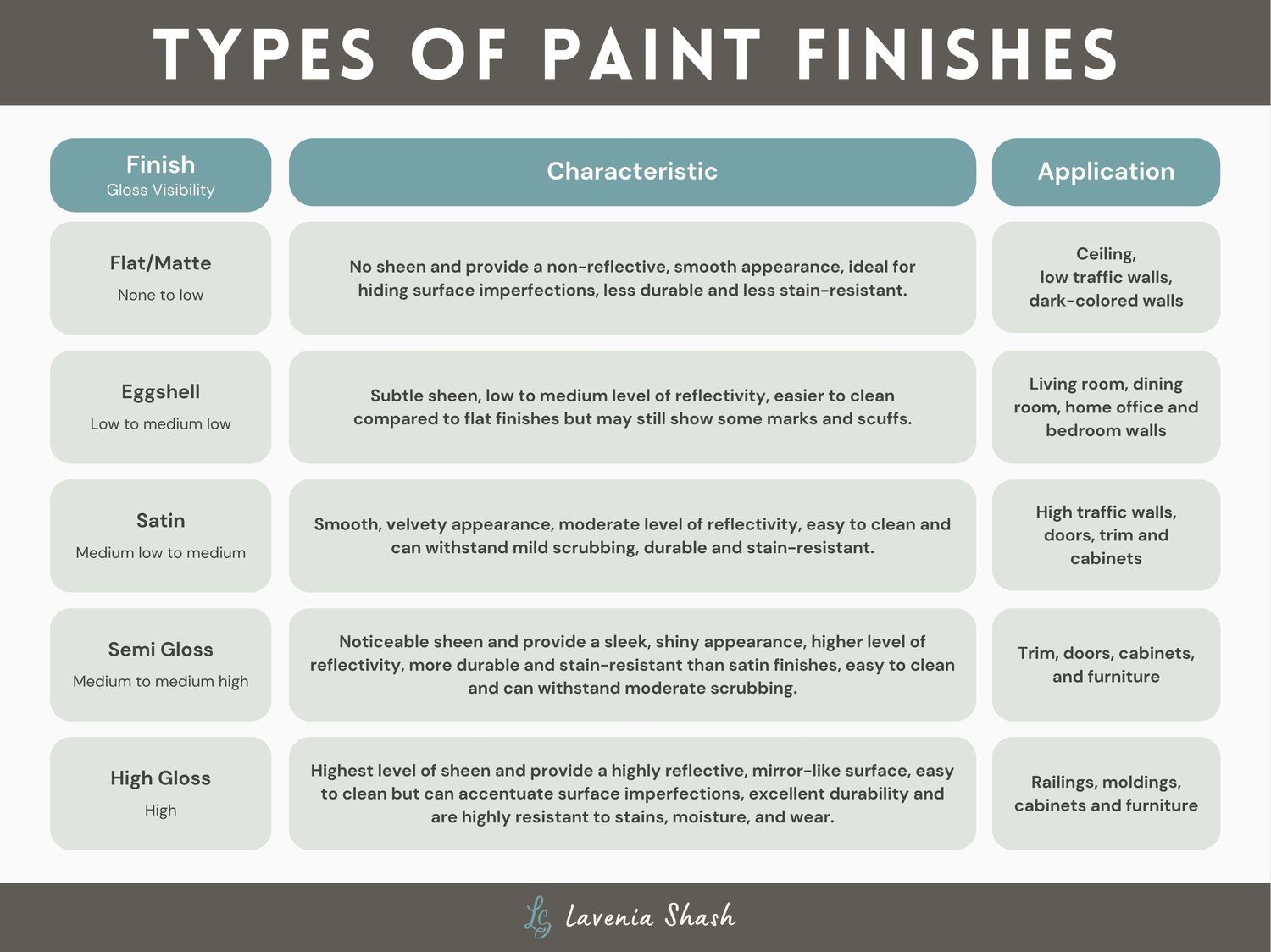
Do different parts of the home's interior need different finishes?
Yes, different parts of the home can indeed benefit from various paint finishes, as each area has its specific characteristics and usage.
However, personal preference plays a significant role in selecting the sheen because it can impact the overall appearance and feel of a room. Some individuals may prefer a more subdued and understated look, opting for flat or matte finishes, while others may prefer a slightly higher sheen to add depth and visual interest to the walls.
By selecting the appropriate finish for each surface, you can enhance both the aesthetic appeal and functionality of different spaces within your home. Here's a handy, recommended list for the most common interior spaces:
Entryway wall - Eggshell or Satin
Eggshell - popular choice, gives a warm and inviting look, hides minor imperfections, easy to clean.
Satin - provides a subtle glow, durable, easy to clean, practical choice for families with kids and pets.
Living room wall - Eggshell or Satin
Eggshell - popular choice, gives a warm and inviting look, hides minor imperfections, easy to clean.
Satin - provides a subtle glow, durable, easy to clean, practical choice for families with kids and pets.
Bedroom wall - Eggshell or Matte(Flat)
Eggshell - popular choice, adds depth and sophistication, easy maintenance.
Matte - understated and velvety appearance, conceals surface imperfections, susceptible to marks and scuffs.
Kid's bedroom wall - Satin or Eggshell
Satin - provides a subtle glow, durable, easy to clean, practical choice for children's room.
Eggshell - gives a warm and inviting look, hides minor imperfections, easy to clean.
Home office wall - Matte(Flat) or Eggshell
Matte - understated and velvety appearance, conceals surface imperfections, suitable for dark and moody rooms.
Eggshell - adds depth and sophistication, easy maintenance, gives a warm and inviting look, hides minor imperfections,.
Bathroom wall - Satin or Semi-Gloss
Satin - popular choice, good durability, resistant to moisture, easy to clean, can withstand mild scrubbing.
Semi-Gloss - suitable for smooth walls, highlights imperfections, reflective surface, highly durable, moisture-resistant, easy to clean.
Dining room wall - Eggshell or Satin
Eggshell - popular choice, gives a warm and inviting look, hides minor imperfections, easy to clean.
Satin - provides a subtle glow, durable, easy to clean, practical choice for spills and splatters.
Laundry room wall - Satin or Eggshell
Satin - good durability, resistant to moisture, easy to clean, practical choice for laundry room.
Eggshell - gives a warm and inviting look, hides minor imperfections, easy to clean.
Mudroom wall - Satin or Semi-Gloss
Satin - popular choice, good durability, resistant to moisture, easy to clean, can withstand mild scrubbing.
Semi-Gloss - suitable for smooth walls, highlights imperfections, reflective surface, highly durable, moisture-resistant, easy to clean.
Kitchen wall - Satin, Semi-Gloss or High Gloss
Satin - subtle sheen good durability, resistant to moisture, easy to clean, can withstand mild scrubbing.
Semi-Gloss - suitable for smooth walls, highlights imperfections, reflective surface, highly durable, moisture-resistant, easy to clean.
Ceiling - Matte (Flat)
Matte/Flat - most commonly used, no sheen, non-reflective surface that minimizes the appearance of flaws and unevenness.
Brick wall (i.e., fireplace) - Eggshell or Satin
Eggshell - gives a warm and inviting look, hides minor imperfections, suits dark and light colored walls.
Satin - provides a subtle glow, durable, easy to clean, works better on white or light-colored walls than dark ones.
Trim, doors and moldings - Satin or Semi-Gloss
Satin - popular choice, good durability, resistant to moisture, easy to clean, for newer or modern homes.
Semi-Gloss - provides a reflective surface, highly durable, moisture-resistant, easy to clean, for older homes.
Kitchen cabinets, vanities and built-ins - Satin or Semi-Gloss
Satin - popular choice, good durability, resistant to moisture, easy to clean, can withstand mild scrubbing.
Semi-Gloss - suitable for smooth surface, highlights imperfections, reflective surface, highly durable, moisture-resistant, easy to clean.
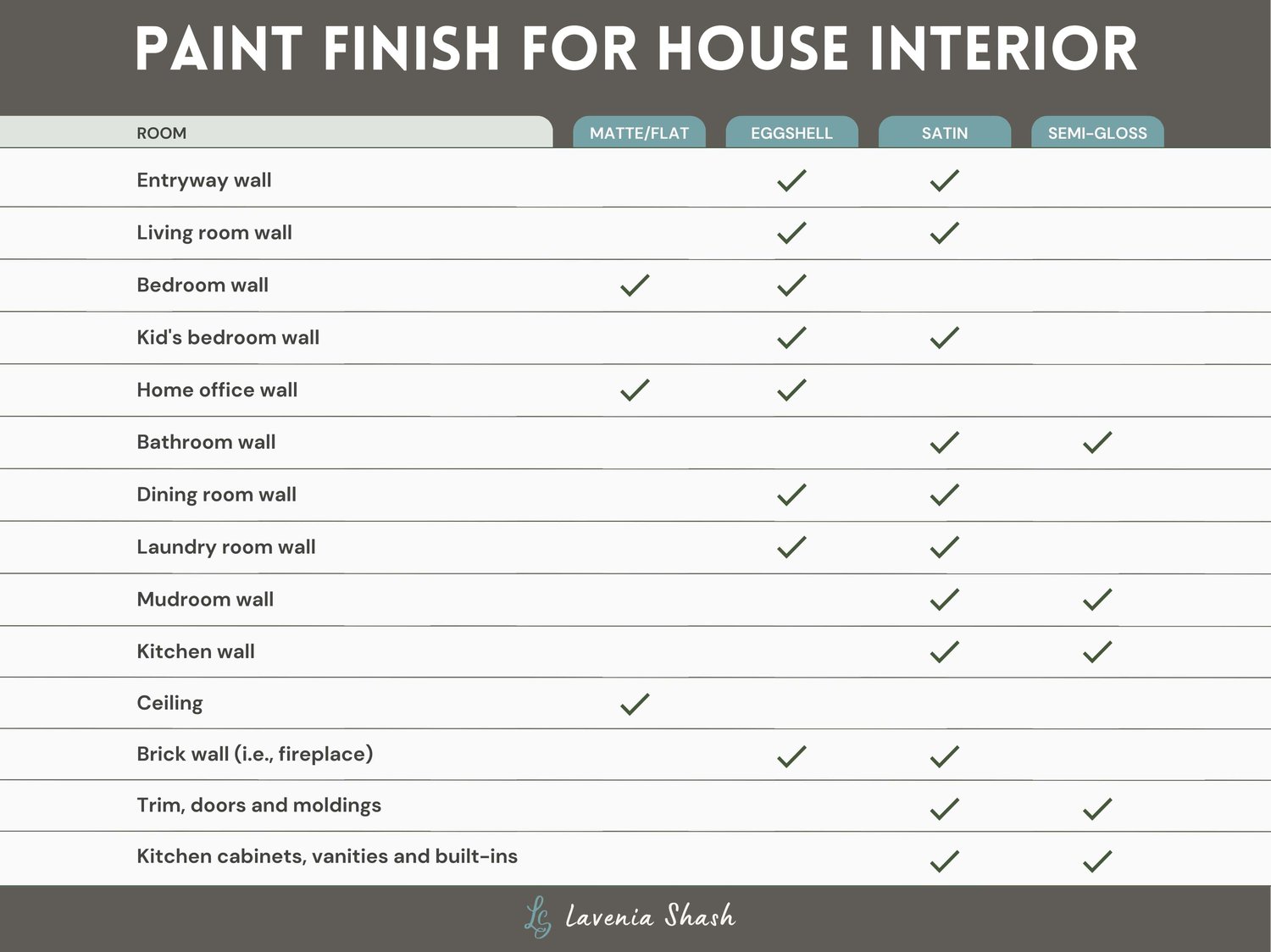
What are the options available for exteriors?
When it comes to exterior paint finishes, there are several options to consider depending on the surface and desired effect. Here are the most commonly used finishes for different areas:
Flat Paint Finish
While not as popular for exteriors, flat paint can be a good choice for older homes with wooden siding or to conceal minor imperfections on exterior walls. Flat finishes are suitable for traditional and rustic architectural styles and can give a subtle, understated appearance to the exterior. It provides a matte appearance but is not recommended for areas that are frequently touched or exposed to weather.
Eggshell Paint Finish
Eggshell is the most popular exterior paint finish for the body of a home. It offers a low-reflective finish and works well on various siding types, such as lap siding and stucco. It provides durability, easy maintenance, and helps conceal minor imperfections on the surface.
Satin Paint Finish
Satin finishes have a nice sheen and are commonly used on exterior trim areas that are frequently used or touched. It offers durability, resistance to peeling and mildew, and is ideal for eaves, soffits, trim boards, porch ceilings, door frames, and window sills. Satin finishes are not recommended for surfaces with visible imperfections.
Semi-Gloss Paint Finish
Semi-gloss finishes offer a visible shine and are perfect for surfaces that require frequent cleaning, such as garage doors, front doors, exterior trim, gutters, shutters, and railings. It provides durability, withstands harsh weather conditions, and is easier to clean compared to satin finishes.
High-Gloss Paint Finish
High-gloss finishes provide an extreme shine and are used to highlight ornate architectural details, trim, doors, and decorative fixtures. They create a glossy, reflective surface that adds drama and visual interest. They also offer excellent durability and richness of color but should be used selectively to avoid making the entire exterior look plastic or magnifying surface imperfections.
Professional painters can help ensure proper preparation and application for semi-gloss and high-gloss finishes to achieve the best results and longevity. It's important to consider the condition of the surface and choose the appropriate finish based on your specific needs and aesthetic preferences.
Which is the most common sheen for a front door?
The most common sheen for a front door is typically a semi-gloss finish. Semi-gloss finishes are a popular choice for front doors. They have a noticeable sheen and provide a sleek, reflective surface. Semi-gloss finishes offer excellent durability, making them well-suited for front doors that are exposed to the elements and frequent use. They are highly resistant to weathering, stains, and scratches. Semi-gloss finishes also add a touch of elegance and visual appeal to the front entrance.
How popular is a satin finish for a front door?
Satin finish for front doors is relatively popular. While semi-gloss and high-gloss finishes are more traditional choices for front doors due to their durability and reflective qualities, satin finishes offer a versatile alternative that appeals to many homeowners.
Satin finishes provide a subtle sheen that falls between matte and semi-gloss. They offer a smooth and refined appearance, adding a touch of sophistication to the front door without being as glossy as higher sheen options. Satin finishes can complement various architectural styles and are particularly favored for modern or contemporary designs, where a more subdued sheen is desired.
One of the advantages of a satin finish is its ability to hide minor imperfections or surface blemishes on the door. It provides good durability and is relatively easy to clean, making it suitable for front doors that are frequently used and exposed to the elements.
What should be taken into consideration before selecting a sheen?
Before selecting a sheen for a wall or woodwork, several factors should be considered to ensure the best outcome. Here are some important considerations:
Lighting
Take into account the lighting conditions of the room. Natural and artificial light can affect the perception of sheen. Rooms with abundant natural light may amplify the shine, while dimly lit areas might benefit from a higher sheen to reflect light and create a brighter ambiance.
Surface Imperfections
Evaluate the condition of the surface you're painting. Sheen can accentuate imperfections, such as bumps or cracks. In general, higher sheens like semi-gloss or high-gloss tend to highlight flaws, while lower sheens like flat or matte finishes can help to hide them.
Traffic and Usage
Consider the level of activity and usage the area will endure. High-traffic areas, such as hallways or kitchens, may benefit from more durable and washable finishes that can withstand frequent cleaning and resist stains. Low-traffic spaces, like bedrooms or formal dining rooms, offer more flexibility in terms of selecting a sheen.
Style and Desired Aesthetic
The desired style and overall aesthetic of the room should influence the choice of sheen. Contemporary or modern designs often lean towards satin or semi-gloss finishes for a sleek and polished look. Traditional or rustic styles might favor matte or eggshell finishes for a softer and more understated appearance.
By considering these factors, you can make an informed decision when selecting the sheen for your walls or woodwork. Remember, it's always a good idea to test samples in the actual space to see how lighting and other elements affect the appearance before committing to a particular sheen.
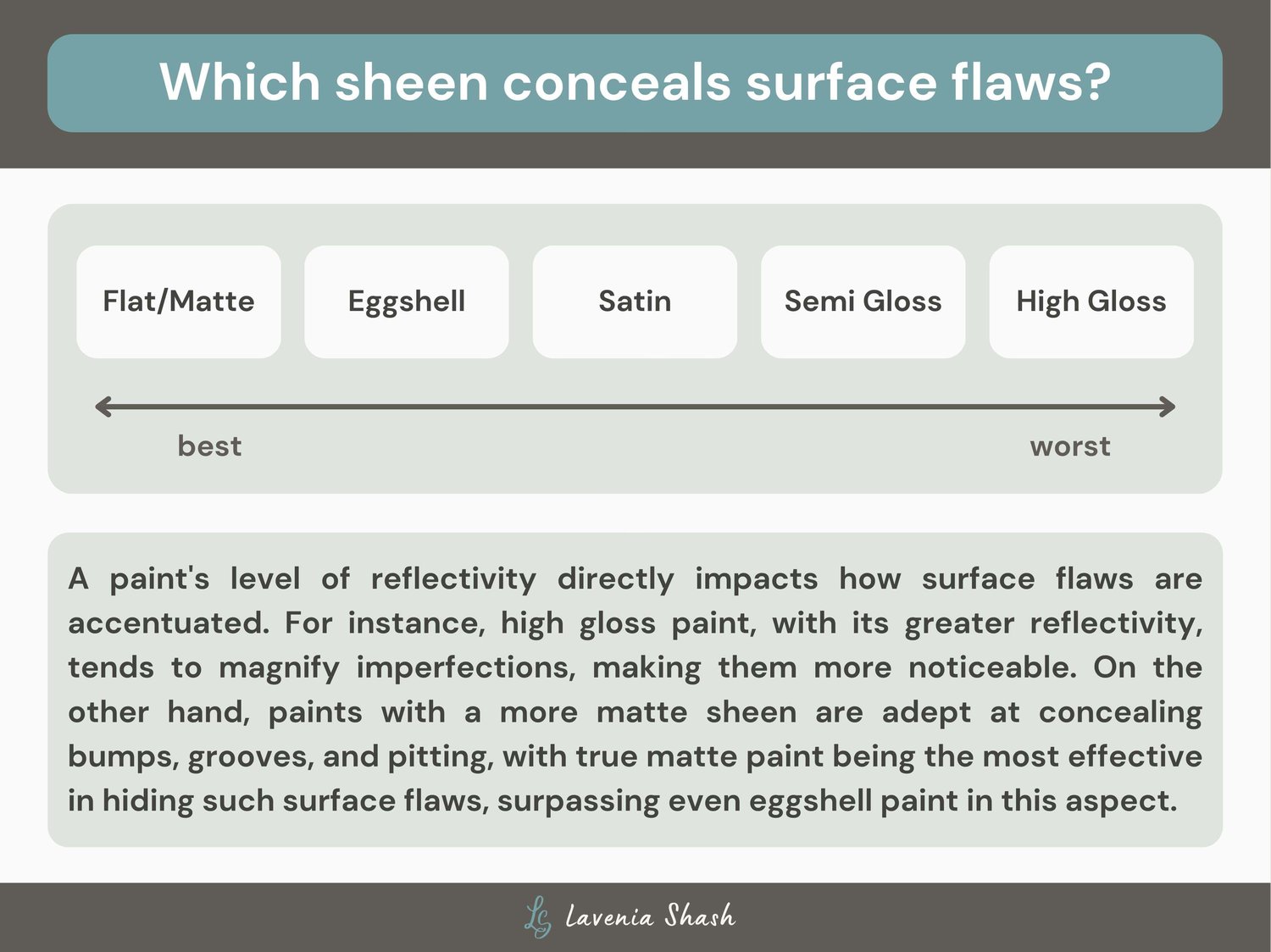
What finish should I choose if I do not favor a shiny look for my walls?
If you prefer a non-shiny look for your walls, there are several finish options that offer a more subdued sheen. Consider the following finishes:
Flat Finish
A flat finish is a great choice if you want to avoid any shine on your walls. It provides a smooth, matte appearance that gives a subtle and elegant look to your space. Flat finishes are excellent at concealing surface imperfections and are often preferred for creating a soft and serene atmosphere. Keep in mind that flat finishes may be less washable and more susceptible to showing marks or stains, so they are best suited for low-traffic areas.
Matte Finish
Matte finishes offer a similar non-reflective quality to flat finishes but typically have a slightly higher sheen level. They provide a velvety appearance that adds depth and richness to your walls while maintaining a low-shine effect. Matte finishes are popular for creating a contemporary and sophisticated look, and they can help to minimize the visibility of surface imperfections.
Eggshell Finish
Eggshell finishes offer a subtle sheen that falls between matte and satin. While they provide a gentle glow, it is not as pronounced as higher sheen finishes. Eggshell finishes are a versatile option that works well in various settings, offering a touch of warmth and sophistication to your walls. They are also more durable and washable compared to flat or matte finishes, making them suitable for areas with moderate traffic.
Why isn't high gloss as popular as the other sheens?
High gloss finishes are not as popular as other sheens for several reasons:
Bold and Dramatic Look
High gloss finishes create a highly reflective and glossy surface that can be quite bold and attention-grabbing. This look may not be suitable for every space or design aesthetic. Many homeowners prefer a more subtle and understated appearance for their walls, which can be achieved with lower sheen finishes like matte or satin.
Surface Imperfections
High gloss finishes tend to highlight surface imperfections more than other sheens. Any bumps, dents, or unevenness on the wall surface can become more noticeable when light reflects off the glossy surface. For this reason, high gloss finishes are often used sparingly on trim, doors, and cabinets where the surfaces are typically smoother and more uniform.
Maintenance and Cleaning
High gloss finishes are more prone to showing fingerprints, smudges, and other marks compared to lower sheen finishes. The reflective surface can amplify the visibility of these imperfections. Cleaning high gloss finishes may require more frequent attention and careful maintenance to keep them looking pristine.
While high gloss finishes may not be as commonly used on walls, they can still have their place in certain design applications, such as accent walls, feature areas, or for creating a bold statement in contemporary or minimalist designs. It's all about finding the right balance and considering the overall look and feel you want to achieve in your space.
What is the best sheen for smooth walls vs rough/damaged walls vs textured walls?
The best sheen for different types of walls can vary based on the condition and texture of the surfaces. Here are some general recommendations for different wall types:
Smooth Walls
Smooth walls without imperfections or texture can work well with a range of sheens. The choice depends on personal preference and the desired aesthetic. Common options include matte or eggshell for a subtle and refined look, or satin for a slightly more reflective finish that adds depth and richness to the walls. Consider factors such as lighting conditions and the overall style of the space when selecting the sheen.
Rough or Damaged Walls
Rough or damaged walls can benefit from sheens that help to minimize imperfections and provide a more forgiving appearance. Matte finishes are often a good choice for these walls as they have a non-reflective, velvety appearance that helps to conceal surface irregularities. Matte finishes can help to smooth out the visual texture and create a cohesive look.
Textured Walls
Textured walls, such as those with techniques like stucco, popcorn, or skip trowel, typically have their own unique look and texture. In most cases, matte or flat finishes are recommended for textured walls as they can help to accentuate the texture without adding additional gloss or shine. Matte finishes tend to absorb light and create subtle shadows, enhancing the depth and character of the textured surfaces. If washability is a concern, you can opt for an eggshell sheen, which offers better durability and ease of cleaning. However, it's important to note that using an eggshell sheen on textured walls may slightly accentuate the texture, adding a subtle dimension to the appearance.
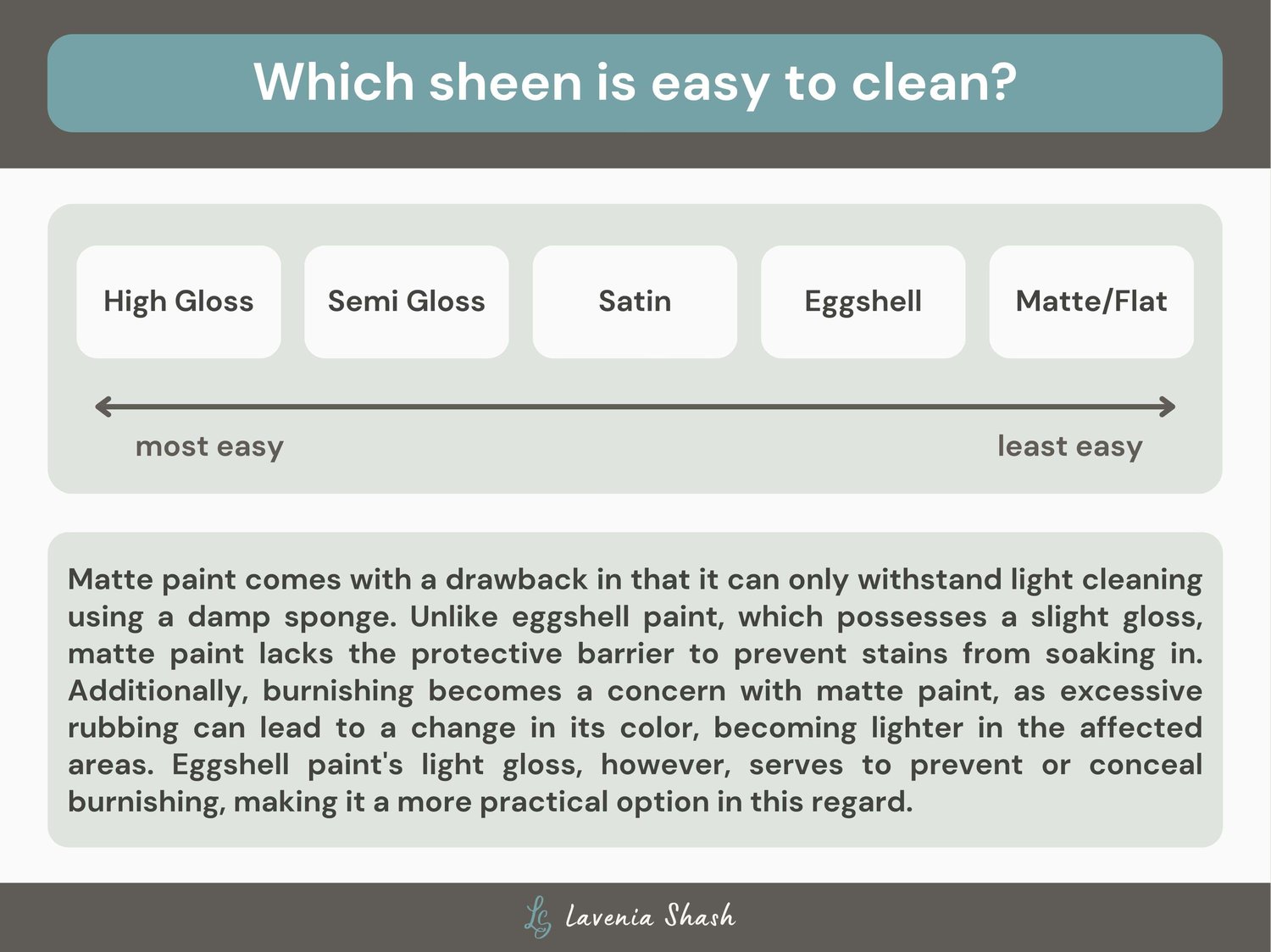
What finish is recommended for white or light colored walls?
For white or light-colored walls, the recommended finish depends on several factors, including the desired aesthetic, functionality, and the level of maintenance you are comfortable with. Here are some common recommendations:
Flat or Matte Finish
Flat or matte finishes are popular choices for white or light-colored walls. They offer a non-reflective, smooth appearance that can create a clean and understated look. Flat finishes tend to hide surface imperfections and provide a soft, velvety texture to the walls. However, it's important to note that flat finishes may be less washable and more prone to showing marks or stains compared to higher sheens.
Eggshell or Satin Finish
Eggshell and satin finishes are also suitable for white or light-colored walls. These finishes have a subtle sheen that adds depth and warmth to the walls. Eggshell finishes strike a balance between a matte and a slightly glossier appearance, while satin finishes provide a smooth, elegant look with a bit more reflectivity. Both eggshell and satin finishes are more durable and easier to clean than flat finishes, making them practical for areas that may require occasional wiping or maintenance.
Semi-Gloss Finish
Semi-gloss finishes offer a higher sheen and more reflectivity compared to flat, matte, or satin finishes. While less commonly used for white or light-colored walls, semi-gloss finishes can be considered for specific areas that require more durability and washability, such as kitchens, bathrooms, or high-traffic areas. Semi-gloss finishes can enhance the light-reflecting properties of white or light-colored walls, but they may also highlight surface imperfections.
What finish is recommended for walls painted in a dark color?
For walls painted in a dark color, the recommended finish depends on various factors, including the desired aesthetic, functionality, and the level of maintenance you are comfortable with. Here are some common recommendations:
Eggshell or Satin Finish
Eggshell and satin finishes are versatile choices for walls painted in dark colors. These finishes offer a subtle sheen that adds depth and richness to the color while providing a smooth and elegant appearance. Eggshell and satin finishes are relatively easy to clean and maintain, making them suitable for most areas of the home, including living rooms, bedrooms, and dining rooms.
Matte Finish
Matte finishes can also be considered for walls painted in dark colors. A matte finish creates a non-reflective, velvety appearance, allowing the dark color to take center stage without distractions. Matte finishes are excellent at hiding surface imperfections and can contribute to a sophisticated and contemporary look. However, it's important to note that matte finishes may be less washable than eggshell or satin finishes and can show marks or stains more easily.
Should the sheen for trims be higher than the finish on a wall?
Yes, it is generally recommended that the sheen of the trim be higher (i.e., glossier) than the finish on the walls. This contrast in finishes helps to create a visual distinction between the trim and the walls, enhancing the overall aesthetic appeal of the space. Here's why it's recommended:
Visual Contrast
By using a higher sheen on the trim compared to the walls, you create a noticeable contrast in finishes. This contrast adds depth and visual interest to the room, drawing attention to the architectural details and highlighting the trim work.
Accentuation of Trim
A glossier finish on the trim brings attention to its clean lines, shapes, and profiles. It helps define the boundaries of the room, creating a crisp and polished look.
Practicality and Durability
Trim, such as baseboards and crown moldings, tends to come into contact with more wear and tear compared to the walls. Using a higher sheen finish, such as satin, semi-gloss or high-gloss, provides added durability and makes the trim easier to clean and maintain.
To achieve the recommended contrast, you can choose a satin, semi-gloss or high-gloss finish for the trim, while selecting a lower sheen such as matte, eggshell or satin for the walls. This combination allows the trim to stand out and adds a touch of sophistication to the overall design.
However, it's important to note that design choices ultimately depend on personal preference and the desired aesthetic. If you prefer a more subtle or cohesive look, you can opt for a closer sheen match between the trim and walls. The key is to consider the overall style and balance of the space when making your decision.
Do different interior design styles call for different paint finishes?
Yes, different paint finishes can be used to complement different interior design styles. The choice of paint finish can contribute to the overall aesthetic and atmosphere of a space. Here are some general recommendations for paint finishes based on popular interior design styles:
Modern Style
Modern design often emphasizes clean lines, simplicity, and a sleek, minimalist look. For modern interiors, paint finishes with a low to moderate sheen like matte or eggshell are commonly used on walls to create a smooth and understated appearance that allows other design elements to take center stage. Matte finishes can help to minimize surface imperfections and create a clean, minimalist aesthetic while Eggshell finishes provide a subtle sheen that adds depth without being overly glossy. These finishes create a contemporary and sophisticated appearance.
Traditional Style
Traditional design embraces classic elegance, intricate details, and a sense of timelessness. For traditional interiors, paint finishes with a slightly higher sheen are typically preferred. Eggshell or satin finishes work well as they offer a touch of luster that enhances the richness of traditional elements. These finishes provide a refined and polished look.
Classic Style
Classic design emphasizes symmetry, balance, and refined aesthetics. For classic interiors, paint finishes with a moderate sheen are often selected. Satin or semi-gloss finishes work effectively in classic spaces, offering a balance between shine and sophistication. These finishes highlight architectural details and add a touch of glamour.
Transitional Style
Transitional design blends elements of traditional and contemporary styles, creating a harmonious and timeless look. For this style, paint finishes with a satin or semi-gloss sheen are commonly used. These finishes provide a balance between the classic elegance of traditional design and the clean lines of contemporary design, resulting in a polished and versatile appearance.
French Country Style
French Country design is inspired by the rustic charm and elegance of French countryside homes. For this style, paint finishes with a matte or eggshell sheen are often preferred. These finishes create a soft and muted look that enhances the warm and inviting atmosphere of French Country interiors.
Colonial Style
Colonial design is rooted in historical architectural styles and embraces a classic and formal aesthetic. For this style, paint finish with a semi-gloss is commonly chosen. These finishes add a touch of sophistication and shine that complements the traditional and refined elements of Colonial interiors.
Retro Style
Retro design draws inspiration from past eras, particularly the mid-20th century. For this style, paint finishes with a satin or semi-gloss sheen are frequently used. These finishes provide a subtle shine that reflects the nostalgic and vibrant character of Retro interiors.
Shabby Chic Style
Shabby Chic design embodies a romantic and vintage-inspired aesthetic with distressed finishes and feminine touches. For this style, paint finishes with a matte or flat sheen are typically preferred. These finishes contribute to the weathered and worn appearance associated with Shabby Chic interiors.
Scandinavian Style
Scandinavian design emphasizes simplicity, natural materials, and a light, airy feel. For this style, paint finishes with a matte or eggshell sheen are often used. These finishes create a soft and understated look, allowing the natural textures and colors of the materials to shine.
Industrial Style
Industrial design embraces a raw, unfinished aesthetic inspired by old factories and warehouses. For this style, paint finishes with a matte or flat sheen are popular. These finishes enhance the rugged and weathered appearance associated with industrial interiors.
Coastal Style
Coastal design is inspired by beachside living, incorporating light colors and natural textures. For this style, paint finishes with a satin or semi-gloss sheen are commonly chosen. These finishes provide a hint of sheen that mimics the reflective qualities of the ocean and add a touch of freshness to the space.
Bohemian Style
Bohemian design embraces an eclectic and free-spirited aesthetic with rich textures and vibrant colors. For this style, paint finishes with a flat or matte sheen work well. These finishes create a relaxed and cozy ambiance that complements the eclectic and artistic elements of bohemian interiors.
Mid-Century Modern Style
Mid-century modern design features clean lines, organic shapes, and a mix of vibrant and neutral colors. For this style, paint finishes with a satin sheen are often preferred. These finishes provide a subtle shine that accentuates the sleek lines and brings out the retro charm of mid-century modern interiors.
Eclectic Style
Eclectic design embraces a mix of various styles, patterns, and textures, creating a unique and personalized space. For this style, a variety of paint finishes can work well depending on the specific elements within the space. However, a common approach is to use a combination of matte, satin, and semi-gloss finishes. This allows for different surfaces to have varying levels of sheen, adding visual interest and depth to the eclectic mix of materials and colors.
Japandi Style
Japandi design is a fusion of Japanese and Scandinavian aesthetics, combining minimalism, natural elements, and clean lines. For this style, paint finishes with a matte or eggshell sheen are often chosen. These finishes provide a calm and serene backdrop that complements the simplicity and natural beauty of Japandi interiors.
Rustic Style
Rustic design embraces a warm and inviting atmosphere with a focus on natural materials and textures. For this style, paint finishes with a matte or flat sheen are commonly used. These finishes create a soft and cozy look that enhances the natural wood elements and earthy color palettes often found in rustic interiors.
Remember that these recommendations are not strict rules, and there is room for personal interpretation and creativity within each design style. Additionally, the choice of paint finish should be considered alongside other design elements such as furniture, lighting, and accessories to achieve a cohesive and harmonious overall look and should ultimately align with your vision and desired atmosphere for the space.
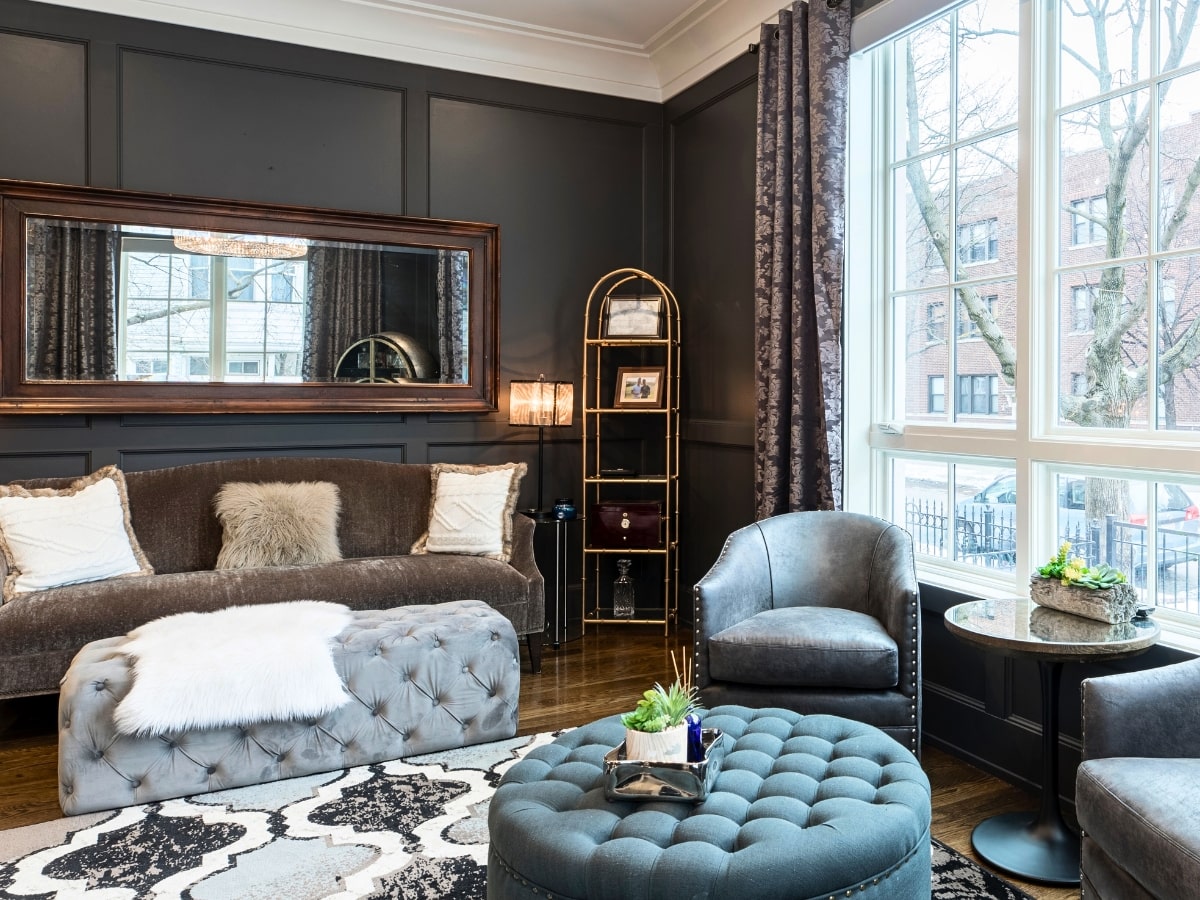
How does natural light interact with sheens?
The interaction between natural light and sheens can significantly impact the appearance and ambiance of a space. Here's how different sheens respond to natural light:
Flat or Matte Sheen
Flat or matte finishes absorb light rather than reflecting it, resulting in a non-reflective, velvety appearance. In rooms with ample natural light, flat or matte sheens can create a soft, diffused lighting effect. They tend to minimize glare and can help to create a calm and serene atmosphere. However, it's important to note that flat or matte finishes may also make a space feel slightly darker or less vibrant, particularly in rooms with limited natural light.
Eggshell or Satin Sheen
Eggshell and satin finishes have a subtle sheen that reflects light to a moderate degree. They strike a balance between matte and glossy, offering a gentle glow and a touch of depth to the walls. In spaces with natural light, eggshell or satin sheens can enhance the brightness and contribute to a warm and inviting atmosphere. These finishes work well in areas where you want to strike a balance between reflecting light and concealing minor imperfections.
Semi-Gloss or Gloss Sheen
Semi-gloss and gloss finishes have higher levels of reflectivity, creating a more pronounced sheen and greater light reflection. They bounce light off the surface, adding brightness and creating a vibrant, visually striking appearance. These sheens are excellent for highlighting architectural details, trim, or surfaces that benefit from a polished and dramatic effect.
How does artificial light interact with sheens?
Artificial light can also significantly affect the appearance and perception of different sheens. Here's how artificial light interacts with various sheens:
Flat or Matte Sheen
Flat or matte finishes tend to absorb artificial light, resulting in a softer and more diffused illumination. This can create a cozy and relaxed atmosphere in a room. Matte finishes are often favored in spaces where you want to minimize glare and create a subdued ambiance.
Eggshell or Satin Sheen
Eggshell and satin finishes reflect artificial light to a moderate extent, offering a gentle glow and adding warmth to the space. These sheens can enhance the richness and depth of the colors in artificial lighting. Eggshell and satin finishes strike a balance between matte and gloss, contributing to a sophisticated and inviting atmosphere.
Semi-Gloss or Gloss Sheen
Semi-gloss and gloss finishes reflect artificial light more prominently, resulting in a brighter and more vibrant illumination. These sheens maximize the light's intensity, creating a polished and dynamic effect. Semi-gloss and gloss finishes are often chosen in areas where you want to amplify the artificial lighting, highlight architectural details, or create a visually striking appearance.
Which sheen to use based on cardinal direction?
There is no specific rule or recommendation regarding which sheen to use based on the cardinal direction (north, south, east, west) of a room or surface. The choice of sheen is primarily based on personal preference, the function of the space, lighting conditions, and the desired aesthetic. However, it's worth considering how natural light interacts with different sheens in different directions:
North-facing rooms
These rooms receive less direct sunlight and can appear cooler and dimmer. To counterbalance this, you may opt for a paint finish with a slightly higher sheen, such as satin or eggshell, to add some reflective quality and help brighten up the space.
South-facing rooms
These rooms receive more direct sunlight throughout the day and tend to be brighter. In such rooms, you have more flexibility in choosing your desired sheen. You can go for a matte or flat finish if you prefer a softer look or select a satin or semi-gloss finish if you want to accentuate the natural light and create a slightly more vibrant appearance.
East-facing rooms
These rooms receive direct morning sunlight, which can be warm and soft. To enhance this natural light and create a welcoming atmosphere, you may consider using finishes like satin or eggshell, which offer a subtle sheen that complements the morning light.
West-facing rooms
These rooms receive direct afternoon sunlight, which tends to be warmer and more intense. In these rooms, you can choose finishes based on your personal preference. You may opt for finishes with a slight sheen, like satin or eggshell, to take advantage of the afternoon light and add a touch of radiance.
Does the quality of paint matter for a sheen's durability?
Yes, the quality of paint does play a crucial role in the durability of a sheen. Higher-quality paints generally contain better ingredients, advanced formulations, and superior binders that contribute to improved performance and longevity of the chosen sheen.
Here's how the quality of paint can impact the durability of a sheen:
Adhesion
High-quality paints are formulated to have excellent adhesion properties. This means that they adhere well to the surface, creating a strong bond that helps the paint withstand wear, abrasion, and moisture. Good adhesion is especially important for sheens in high-traffic areas or surfaces that are frequently touched or cleaned.
Resistance to Stains and Scratches
High-quality paints often have enhanced resistance to stains, scratches, and scuffs. They are formulated to create a tougher, more durable surface that can withstand daily use and maintain its appearance over time. This is particularly important for sheens used in areas prone to smudges, fingerprints, or impact, such as doors, trim, or heavily used walls.
Washability
The washability of a sheen refers to its ability to be cleaned without damage or alteration to the finish. Higher-quality paints tend to have better washability, making them easier to clean without compromising the integrity of the sheen. This is important for sheens in areas exposed to dirt, grease, or moisture, such as kitchens, bathrooms, or high-traffic zones.
Color Retention
High-quality paints are formulated to have better color retention over time. They are less prone to fading, discoloration, or yellowing, ensuring that the chosen sheen maintains its original appearance and color vibrancy for a longer duration.
UV Protection
Certain high-quality paints include additives or UV-resistant properties that help protect the sheen and underlying surfaces from the damaging effects of ultraviolet (UV) rays. This is particularly beneficial for exterior sheens exposed to direct sunlight, as it helps maintain their color and prevents premature degradation.
While the quality of paint is important for sheen durability, it's equally essential to ensure proper surface preparation, application techniques, and following the manufacturer's guidelines for the specific paint product. Properly preparing the surface, such as cleaning, priming, and repairing any damages, and applying multiple coats as recommended, will help maximize the durability and longevity of the chosen sheen.
Which manufacturers produce high quality and durable wall paints?
There are several manufacturers known for producing high-quality and durable wall paints. Here are some reputable brands that are often recognized for their paint products:
Sherwin-Williams
Sherwin-Williams is a well-established paint manufacturer known for its wide range of high-quality paints. Their products are often praised for their durability, coverage, and color retention. They offer various finishes and specialty paints to cater to different needs and surfaces.
Benjamin Moore
Benjamin Moore is another trusted brand that offers a diverse selection of premium paints. Their products are known for their excellent durability, fade resistance, and extensive color options. Benjamin Moore paints are often favored by professionals and homeowners alike.
Behr
Behr is a popular brand available at Home Depot that offers a range of paints known for their durability and value. They provide a wide selection of colors, finishes, and specialty paints to meet different requirements. Behr's paints are generally regarded as high-quality and reliable options.
PPG
PPG, formerly known as PPG Industries, is a global manufacturer of paints and coatings. They offer a comprehensive line of paint products known for their durability, color vibrancy, and performance. PPG paints are commonly used in both residential and commercial applications.
Valspar
Valspar is a well-known brand available at Lowe's that offers a range of high-quality paints. They are praised for their durability, coverage, and color consistency. Valspar offers a wide variety of finishes and specialty paints to suit different surfaces and needs.
It's important to note that the performance and quality of specific paint products may vary within each brand. It's recommended to consult with professionals, read reviews, and consider the specific requirements of your project to select the most suitable paint product for your needs.
Final thoughts
The choice of sheen is subjective and often comes down to personal preference. Different individuals may have different preferences for the level of sheen they desire in their space. Some people may prefer a more matte or flat look, while others may prefer a subtle or higher sheen.
The general rule of thumb is that finishes with a more matte appearance, such as flat or matte finishes, tend to be more challenging to clean compared to glossier finishes. On the other hand, glossier finishes, such as semi-gloss or high-gloss, have a smoother surface that allows for easier cleaning and scrubbing.
It's important to note that while glossier finishes may offer better washability and scrub resistance, they may also highlight surface imperfections or show scratches more prominently. Therefore, the choice of finish should consider both the desired level of durability and the desired aesthetic.
Testing paint samples in your space and observing how different sheens interact with the lighting and overall aesthetics can help you make an informed decision based on your personal taste and the desired look you want to achieve.
Meanwhile...
If you are looking for paint colors for your home or space, check this out..
Choosing paint colors for your home can indeed be a challenging task. However, I'm here to simplify the process for you. Introducing my carefully curated paint palettes, designed to offer complementary, and coordinating colors suitable for various areas within your home.
The thoughtfully chosen set of colors in every paint palette ensure a harmonious and unified look throughout your home, allowing for seamless transitions between different areas while maintaining a cohesive overall aesthetic. Whether you're looking to refresh a single room or create a consistent theme across your entire living space, my paint palettes offer versatile and stylish solutions.
I have dedicated significant time and effort to curate each comprehensive, digital download PDF guide that showcases a collection of meticulously selected colors. Every color has been hand-picked with careful consideration of their undertones and compatibility, ensuring they work harmoniously together to create a cohesive and visually pleasing palette.
By providing you with professional advice and tips through informative PDFs, I aim to streamline your decision-making process and provide you with valuable resources that simplifies your journey towards a beautifully coordinated home.
With my expertise, I have assisted countless clients in uncovering paint colors that truly resonate with them. I am eager to extend my assistance to you as well, ensuring that you discover the perfect palette that brings joy and satisfaction to your space.
Should you have any questions about the colors prior to purchase, please get in touch with me by filling in the contact form.
I am reachable for advice post-purchase too!
Much success,
Lavenia Shash
All written content is the copyright of Lavenia Shash. Lavenia is a qualified interior and graphic designer. With a profound expertise, she excels in the art of creating cohesive and harmonious color schemes that perfectly suit both homes and individual styles.
Blog Posts

Lavenia, an e-color consultant, has been pivotal in aiding numerous clients and homeowners in selecting the ideal paint for their living spaces. With over three decades of experience, she has refined her expertise as a skilled designer in both interior and graphic design, along with extensive involvement in the publishing sector. Moreover, she holds certification in social media marketing, broadening her professional capabilities. View Lavenia's curated paint color palettes here.
